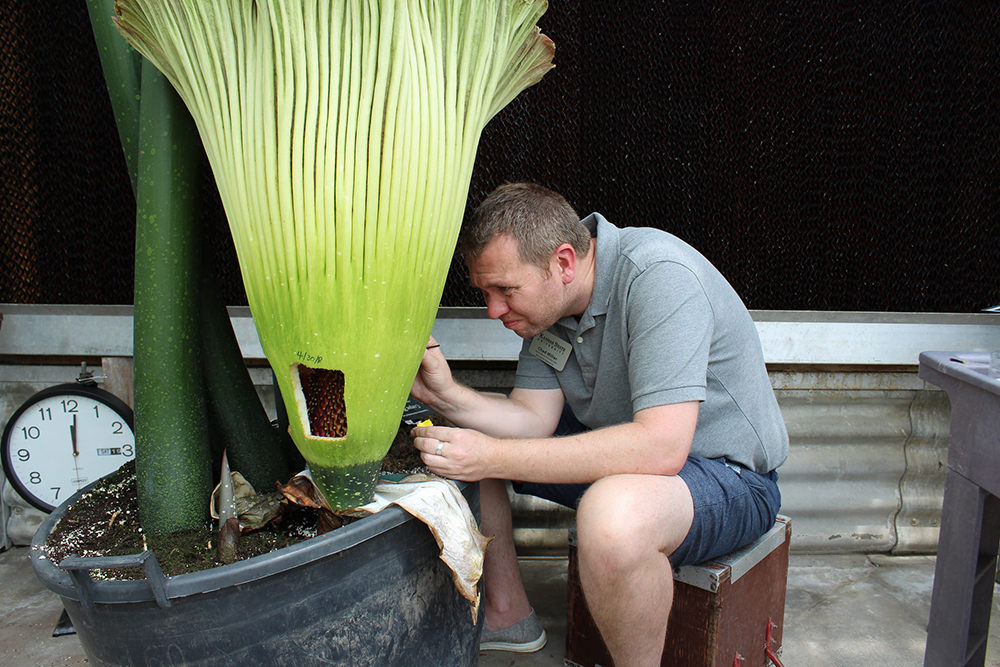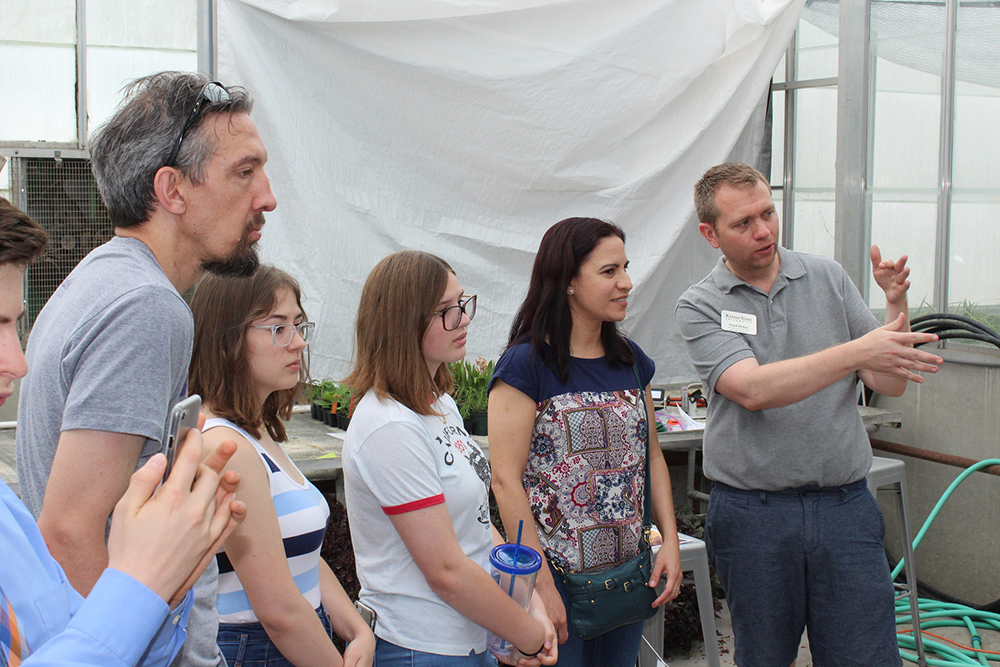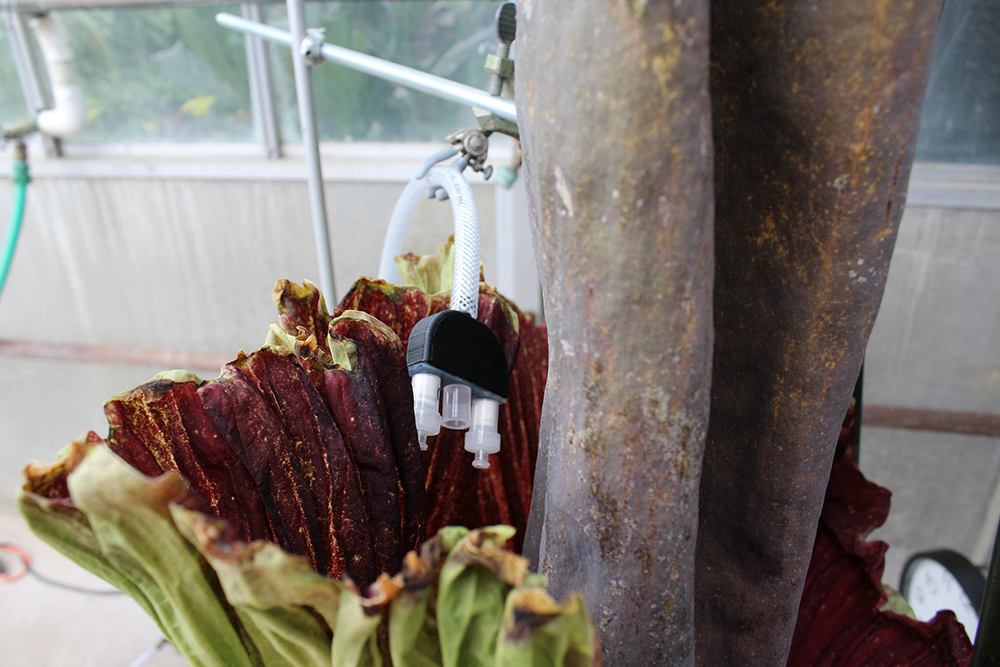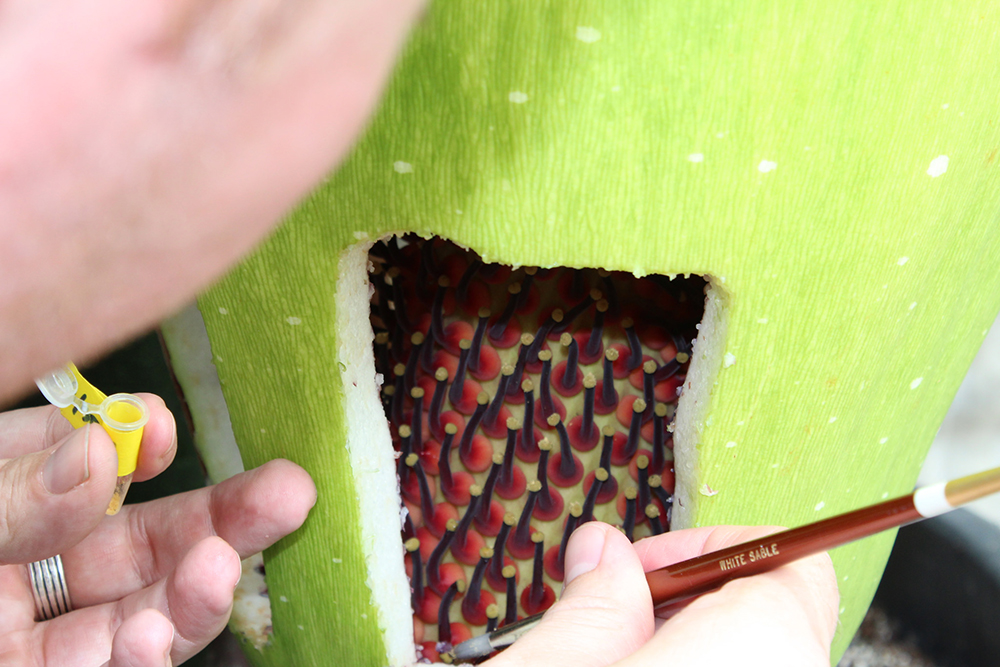
After cutting a window in the side of the spathe (the green outer "leaf" of the bloom), Chad Miller applied pollen, by hand. A highly-specialized piece of equipment was used to cut into the spathe: a serrated blade from a $5 Halloween pumpkin carving kit. | Download this photo.
K-State corpse flower blooms again, less than a year later
Rare repeat offers better preparation, research opportunities
May 30, 2018
MANHATTAN, Kan. — For the second consecutive year, a titan arum (better known as a corpse flower) has bloomed at Kansas State University.
Last year’s bloom was the first for the tropical plant, a gift to the university back in 2001. In its native southeast Asian habitat, titan arum can take more than 10 years to produce its first bloom.
“It was a little surprising to see another one so quick,” said Chad Miller, an associate professor of landscape horticulture at K-State. “But it sort of makes sense – we have a unique rare plant in the sense that it has several leaves, in addition to an inflorescence at the same time. Normally a plant has one leaf or one inflorescence at a time. Those leaves are basically helping to build the tuber down under the soil, so that it has enough carbohydrates or nutrition down there to support the energy needed to develop a large inflorescence, and the accompanying smell. And because we didn’t pollinate and have seed set last year, more energy was able to be stored.”
While Miller was caught by surprise in 2017, this year he knew what to look for. He said he noticed the developing inflorescence about three weeks ago.
“Because we were finishing the semester, I had two finals to give and projects to grade, so I had to make sure all that was done first,” he said.
While the titan arum is a rare plant, native only to Sumatra and Java, modern greenhouse technology has allowed it to be cultivated around the globe. A list of just some of the other places it can be found in the United States includes California, Arizona, North Carolina, New York and Illinois.
In its native habitat, the titan arum is pollinated by flies and carrion beetles that are attracted to the plant by its strong (even overpowering) stench. In greenhouses and botanical gardens, the plant is pollinated by overnight delivery.
“The folks at the Chicago Botanic Garden were very gracious to share some pollen, several vials of pollen that had been harvested at different times and stages of the blooming process of their recent inflorescence,” Miller said.
Using a small paintbrush, Miller carefully applied the donated pollen to the lower part or female florets of the K-State bloom. If there was successful fertilization, he should be able to harvest seed in about 6 months.
“I also harvested pollen from our plant. If we can set up a long-term storage solution, I can save the pollen and then certainly share it with Chicago, and other gardens and institutions when they have a flowering event or two, that they might want to do the cross pollination,” he said.
The educational displays, the live feed, talking with visitors – it all makes for a very non-typical day at the office, or greenhouse.
“I’ve told visitors this is really – for lack of better words – it's a ‘side show’ to what I normally do. I’m still learning about this plant, as everybody else is,” Miller said.
“I look forward to more opportunities to learn more about it.”

Chad Miller (right), discusses the titan arum or "corpse flower" bloom at Kansas State University on Saturday, May 19, 2018. | Download this photo.

Sampling the gases emitted by the bloom. Chemical compounds will be analyzed. | Download this photo.

Looking down inside the bloom. | Download this photo.

In the jungles of Sumatra and Java, titan arum is pollinated by flies and beetles; in greenhouses and botanical gardens, titan arum is pollinated by overnight delivery. The pollen was shared by the Chicago Botanic Garden. A small artist's paint brush was used to apply the pollen. | Download this photo.

The peduncle is inside the spathe. "Male" pollen is towards the top, the cluster of yellow. The "female" flowers are below. | Download this photo.

Using the paintbrush, bits of pollen are dabbed onto each of the female flowers. With any luck, the flowers will grow small round "fruit." The pollen will be harvested, put into long-term storage, and shared with other universities and gardens. | Download this photo.

